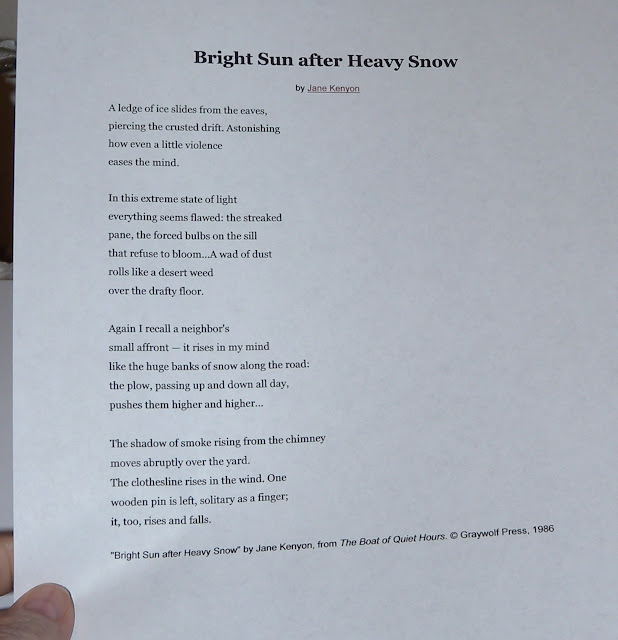This morning we hold a print-out of the WRITERS ALMANAC daily poem, Bright Sun after Heavy Snow by Jane Kenyon. Anyone can get this website, and as SRN readers know, it is a mainstay for us. Bonnie Camp is to be thanked for that.
Jane Kenyon
1947–1995
New
Hampshire's poet laureate at the time of her untimely death at age forty-seven,
Jane Kenyon was noted for verse that probed the inner psyche, particularly with
regard to her own battle against the depression that lasted throughout much of
her adult life. Writing for the last two decades of her life at her farm in
northern New England, Kenyon is also remembered for her stoic portraits of
domestic and rural life; as essayist Gary Roberts noted in Contemporary
Women Poets, her poetry was "acutely faithful to the familiarities and
mysteries of home life, and it is distinguished by intense calmness in the face
of routine disappointments and tragedies."
Born inAnn Arbor , Michigan ,
Kenyon spent her first two decades in the Midwest, attending the University of Michigan University of
Michigan New Hampshire
Kenyon published only four volumes of poetry during her life: From Room to Room,The Little Boat, Let Evening Come, andConstance , and translated a volume of works by the
Russian poet Anna Akhmatova.
Despite her relatively small output, her poetry was highly lauded by critics
throughout her lifetime. As fellow poet Carol Muske remarked in the New
York Times when describing Kenyon's The Boat of Quiet Hours,
"These poems surprise beauty at every turn and capture truth at its
familiar New England slant. Here, in Keats's
terms, is a capable poet." Indeed, Kenyon's work has often been compared
with that of English Romantic poet John Keats;
Roberts dubbed her a "Keatsian poet" and noted that, "like
Keats, she attempts to redeem morbidity with a peculiar kind of gusto, one
which seeks a quiet annihilation of self-identity through identification with
benign things."
The cycles of nature held special significance for Kenyon, who returned to them again and again, both in her variations on Keats's ode "To Autumn," and in other pastoral verse. In Let Evening Come, her third published collection—and one that found the poet taking what Poetry essayist Paul Breslin called "a darker turn"—Kenyon explored nature's cycles in other ways: the fall of light from day to dusk to night, and the cycles of relationships with family and friends throughout a long span of years brought to a close by death. Let Evening Come "shows [Kenyon] at the height of her powers," according to Muske in a review of the 1990 volume for the New York Times Book Review, with the poet's "descriptive skills . . . as notable as her dramatic ones. Her rendering of natural settings, in lines of well-judged rhythm and simple syntax, contribute to the [volume's] memorableness."
Constance began Kenyon's study of
depression, and her work in this regard has been compared with that of the late
poet Sylvia Plath.
Comparing the two, Breslin wrote that "Kenyon's language is much quieter,
less self-dramatizing" than that of Plath, and where the earlier poet
"would give herself up, writing her lyrical surrender to oblivion, . . .
Kenyon fought to the end." Breslin noted the absence of self-pity in
Kenyon's work, and the poet's ability to separate from self and acknowledge the
grief and emotional pain of others, as in her poems "Coats,"
"Sleepers in Jaipur," and "Gettysburg
In Otherwise, a posthumous collection containing twenty poems written just prior to her death as well as several taken from her earlier books, Kenyon "chronicles the uncertainty of living as culpable, temporary creatures," according to Nationcontributor Emily Gordon. As Muske added in the New York Times Book Review, Kenyon avoids sentimentality throughout Otherwise. "The poet here sears a housewife's apron, hangs wash on the line, walks a family dog and draws her thought from a melancholy, ecstatic soul as if from the common well, 'where the fearful and rash alike must come for water.' In ecstasy," Muske continued, Kenyon "sees this world as a kind of threshold through which we enter God's wonder."
Born in
Kenyon published only four volumes of poetry during her life: From Room to Room,The Little Boat, Let Evening Come, and
The cycles of nature held special significance for Kenyon, who returned to them again and again, both in her variations on Keats's ode "To Autumn," and in other pastoral verse. In Let Evening Come, her third published collection—and one that found the poet taking what Poetry essayist Paul Breslin called "a darker turn"—Kenyon explored nature's cycles in other ways: the fall of light from day to dusk to night, and the cycles of relationships with family and friends throughout a long span of years brought to a close by death. Let Evening Come "shows [Kenyon] at the height of her powers," according to Muske in a review of the 1990 volume for the New York Times Book Review, with the poet's "descriptive skills . . . as notable as her dramatic ones. Her rendering of natural settings, in lines of well-judged rhythm and simple syntax, contribute to the [volume's] memorableness."
In Otherwise, a posthumous collection containing twenty poems written just prior to her death as well as several taken from her earlier books, Kenyon "chronicles the uncertainty of living as culpable, temporary creatures," according to Nationcontributor Emily Gordon. As Muske added in the New York Times Book Review, Kenyon avoids sentimentality throughout Otherwise. "The poet here sears a housewife's apron, hangs wash on the line, walks a family dog and draws her thought from a melancholy, ecstatic soul as if from the common well, 'where the fearful and rash alike must come for water.' In ecstasy," Muske continued, Kenyon "sees this world as a kind of threshold through which we enter God's wonder."



